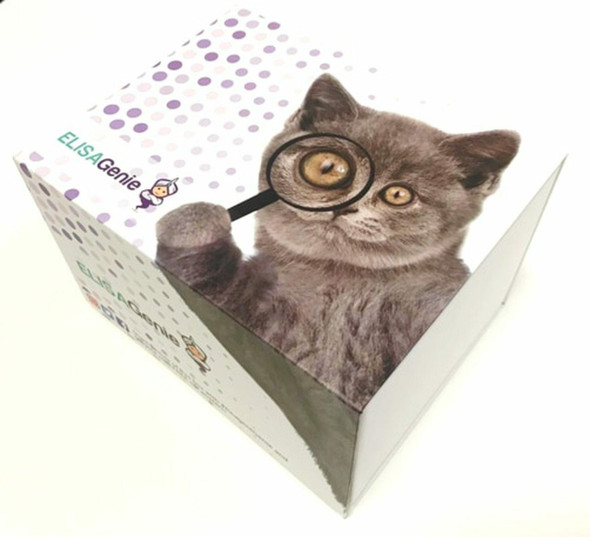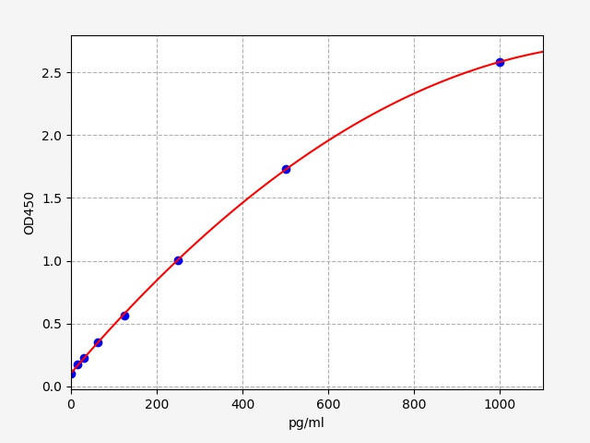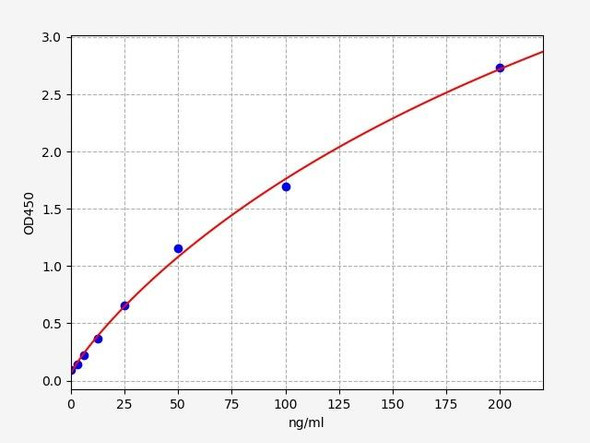Human Cell Biology ELISA Kits 5
Human cADPRH/CD38 (Cyclic ADP Ribose Hydrolase) CLIA Kit (HUES00923)
- SKU:
- HUES00923
- Product Type:
- ELISA Kit
- ELISA Type:
- CLIA Kit
- Size:
- 96 Assays
- Sensitivity:
- 0.19ng/mL
- Range:
- 0.31-20ng/mL
- ELISA Type:
- Sandwich
- Synonyms:
- T10, p45
- Reactivity:
- Human
- Sample Type:
- Serum, plasma and other biological fluids
- Research Area:
- Cell Biology
Description
| Assay type: | Sandwich |
| Format: | 96T |
| Assay time: | 4.5h |
| Reactivity: | Human |
| Detection method: | Chemiluminescence |
| Detection range: | 0.31-20 ng/mL |
| Sensitivity: | 0.19 ng/mL |
| Sample volume: | 100µL |
| Sample type: | Serum, plasma and other biological fluids |
| Repeatability: | CV < 15% |
| Specificity: | This kit recognizes Human cADPRH/CD38 in samples. No significant cross-reactivity or interference between Human cADPRH/CD38 and analogues was observed. |
This kit uses Sandwich-CLIA as the method. The micro CLIA plate provided in this kit has been pre-coated with an antibody specific to Human cADPRH/CD38. Standards or samples are added to the appropriate micro CLIA plate wells and combined with the specific antibody. Then a biotinylated detection antibody specific for Human cADPRH/CD38 and Avidin-Horseradish Peroxidase (HRP) conjugate are added to each micro plate well successively and incubated. Free components are washed away. The substrate solution is added to each well. Only those wells that contain Human cADPRH/CD38, biotinylated detection antibody and Avidin-HRP conjugate will appear fluorescence. The Relative light unit (RLU) value is measured spectrophotometrically by the Chemiluminescence immunoassay analyzer. The RLU value is positively associated with the concentration of Human cADPRH/CD38. The concentration of Human cADPRH/CD38 in the samples can be calculated by comparing the RLU of the samples to the standard curve.
| UniProt Protein Function: | CD38: Synthesizes cyclic ADP-ribose, a second messenger for glucose-induced insulin secretion. Also has cADPr hydrolase activity. Also moonlights as a receptor in cells of the immune system. Belongs to the ADP-ribosyl cyclase family. 2 isoforms of the human protein are produced by alternative splicing. |
| UniProt Protein Details: | Protein type:EC 3. 2. 2. 6; EC 2. 4. 99. 20; Cofactor and Vitamin Metabolism - nicotinate and nicotinamide; Hydrolase; Cell surface; Apoptosis; Lyase; Membrane protein, integral; Cell cycle regulation Chromosomal Location of Human Ortholog: 4p15 Cellular Component: cell surface; membrane; integral to membrane; plasma membrane; nucleus Molecular Function:transferase activity; phosphorus-oxygen lyase activity; NAD+ nucleosidase activity; NAD(P)+ nucleosidase activity Biological Process: response to drug; response to retinoic acid; metabolic process; positive regulation of transcription, DNA-dependent; positive regulation of insulin secretion; female pregnancy; signal transduction; positive regulation of cell growth; response to estradiol stimulus; B cell receptor signaling pathway; elevation of cytosolic calcium ion concentration; response to hydroperoxide; positive regulation of B cell proliferation; positive regulation of vasoconstriction; response to hypoxia; response to progesterone stimulus; negative regulation of transcription, DNA-dependent; negative regulation of bone resorption; negative regulation of apoptosis |
| NCBI Summary: | CD38 is a novel multifunctional ectoenzyme widely expressed in cells and tissues especially in leukocytes. CD38 also functions in cell adhesion,signal transduction and calcium signaling. [provided by RefSeq, Jul 2008] |
| UniProt Code: | P28907 |
| NCBI GenInfo Identifier: | 55977782 |
| NCBI Gene ID: | 952 |
| NCBI Accession: | P28907. 2 |
| UniProt Secondary Accession: | P28907,O00121, O00122, Q96HY4, |
| UniProt Related Accession: | P28907 |
| Molecular Weight: | 300 |
| NCBI Full Name: | ADP-ribosyl cyclase/cyclic ADP-ribose hydrolase 1 |
| NCBI Synonym Full Names: | CD38 molecule |
| NCBI Official Symbol: | CD38 |
| NCBI Official Synonym Symbols: | T10; ADPRC 1 |
| NCBI Protein Information: | ADP-ribosyl cyclase/cyclic ADP-ribose hydrolase 1; cADPr hydrolase 1; CD38 antigen (p45); NAD(+) nucleosidase; ADP-ribosyl cyclase 1; 2'-phospho-ADP-ribosyl cyclase; 2'-phospho-cyclic-ADP-ribose transferase; 2'-phospho-ADP-ribosyl cyclase/2'-phospho-cyclic-ADP-ribose transferase |
| UniProt Protein Name: | ADP-ribosyl cyclase/cyclic ADP-ribose hydrolase 1 |
| UniProt Synonym Protein Names: | 2'-phospho-ADP-ribosyl cyclase; 2'-phospho-ADP-ribosyl cyclase/2'-phospho-cyclic-ADP-ribose transferase (EC:2. 4. 99. 20); 2'-phospho-cyclic-ADP-ribose transferase; ADP-ribosyl cyclase 1; ADPRC 1; Cyclic ADP-ribose hydrolase 1; cADPr hydrolase 1; T10; CD_antigen: CD38 |
| Protein Family: | ADP-ribosyl cyclase/cyclic ADP-ribose hydrolase |
| UniProt Gene Name: | CD38 |
| UniProt Entry Name: | CD38_HUMAN |
As the RLU values of the standard curve may vary according to the conditions of the actual assay performance (e. g. operator, pipetting technique, washing technique or temperature effects), the operator should establish a standard curve for each test. Typical standard curve and data is provided below for reference only.
| Concentration (ng/mL) | RLU | Average | Corrected |
| 20 | 33184 34780 | 33982 | 33950 |
| 10 | 11592 13348 | 12470 | 12438 |
| 5 | 5591 4909 | 5250 | 5218 |
| 2.5 | 2299 2749 | 2524 | 2492 |
| 1.25 | 1399 1367 | 1383 | 1351 |
| 0.63 | 889 845 | 867 | 835 |
| 0.31 | 596 650 | 623 | 591 |
| 0 | 30 34 | 32 | -- |
Precision
Intra-assay Precision (Precision within an assay): 3 samples with low, mid range and high level Human cADPRH/CD38 were tested 20 times on one plate, respectively.
Inter-assay Precision (Precision between assays): 3 samples with low, mid range and high level Human cADPRH/CD38 were tested on 3 different plates, 20 replicates in each plate.
| Intra-assay Precision | Inter-assay Precision | |||||
| Sample | 1 | 2 | 3 | 1 | 2 | 3 |
| n | 20 | 20 | 20 | 20 | 20 | 20 |
| Mean (ng/mL) | 1.08 | 2.73 | 8.03 | 1.07 | 2.76 | 8.15 |
| Standard deviation | 0.12 | 0.27 | 0.81 | 0.10 | 0.31 | 0.57 |
| C V (%) | 11.11 | 9.89 | 10.09 | 9.35 | 11.23 | 6.99 |
Recovery
The recovery of Human cADPRH/CD38 spiked at three different levels in samples throughout the range of the assay was evaluated in various matrices.
| Sample Type | Range (%) | Average Recovery (%) |
| Serum (n=5) | 96-112 | 103 |
| EDTA plasma (n=5) | 97-113 | 104 |
| Cell culture media (n=5) | 99-112 | 105 |
Linearity
Samples were spiked with high concentrations of Human cADPRH/CD38 and diluted with Reference Standard & Sample Diluent to produce samples with values within the range of the assay.
| Serum (n=5) | EDTA plasma (n=5) | Cell culture media (n=5) | ||
| 1:2 | Range (%) | 98-114 | 104-119 | 94-105 |
| Average (%) | 104 | 110 | 100 | |
| 1:4 | Range (%) | 86-100 | 93-105 | 89-101 |
| Average (%) | 93 | 100 | 95 | |
| 1:8 | Range (%) | 97-110 | 87-98 | 89-102 |
| Average (%) | 103 | 92 | 96 | |
| 1:16 | Range (%) | 94-108 | 93-108 | 93-109 |
| Average (%) | 99 | 99 | 100 |
An unopened kit can be stored at 4°C for 1 month. If the kit is not used within 1 month, store the items separately according to the following conditions once the kit is received.
| Item | Specifications | Storage |
| Micro CLIA Plate(Dismountable) | 8 wells ×12 strips | -20°C, 6 months |
| Reference Standard | 2 vials | |
| Concentrated Biotinylated Detection Ab (100×) | 1 vial, 120 µL | |
| Concentrated HRP Conjugate (100×) | 1 vial, 120 µL | -20°C(shading light), 6 months |
| Reference Standard & Sample Diluent | 1 vial, 20 mL | 4°C, 6 months |
| Biotinylated Detection Ab Diluent | 1 vial, 14 mL | |
| HRP Conjugate Diluent | 1 vial, 14 mL | |
| Concentrated Wash Buffer (25×) | 1 vial, 30 mL | |
| Substrate Reagent A | 1 vial, 5 mL | 4°C (shading light) |
| Substrate Reagent B | 1 vial, 5 mL | 4°C (shading light) |
| Plate Sealer | 5 pieces | |
| Product Description | 1 copy | |
| Certificate of Analysis | 1 copy |
- Set standard, test sample and control (zero) wells on the pre-coated plate and record theirpositions. It is recommended to measure each standard and sample in duplicate. Note: addall solutions to the bottom of the plate wells while avoiding contact with the well walls. Ensuresolutions do not foam when adding to the wells.
- Aliquot 100 µL of standard solutions into the standard wells.
- Add 100 µL of Sample / Standard dilution buffer into the control (zero) well.
- Add 100 µL of properly diluted sample (serum, plasma, tissue homogenates and otherbiological fluids. ) into test sample wells.
- Cover the plate with the sealer provided in the kit and incubate for 90 min at 37 °C.
- Aspirate the liquid from each well, do not wash. Immediately add 100 µL of BiotinylatedDetection Ab working solution to each well. Cover the plate with a plate seal and gently mix. Incubate for 1 hour at 37 °C.
- Aspirate or decant the solution from the plate and add 350 µL of wash buffer to each welland incubate for 1-2 minutes at room temperature. Aspirate the solution from each well andclap the plate on absorbent filter paper to dry. Repeat this process 3 times. Note: a microplatewasher can be used in this step and other wash steps.
- Add 100 µL of HRP Conjugate working solution to each well. Cover with a plate seal andincubate for 30 min at 37 °C.
- Aspirate or decant the solution from each well. Repeat the wash process for five times asconducted in step 7.
- Add 100 µL of Substrate mixture solution to each well. Cover with a new plate seal andincubate for no more than 5 min at 37 °C. Protect the plate from light.
- Determine the RLU value of each well immediately.






